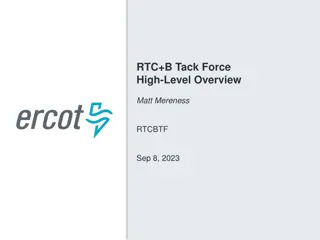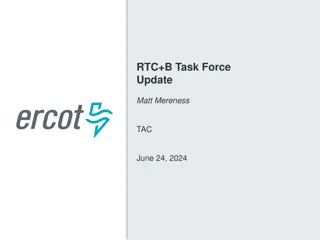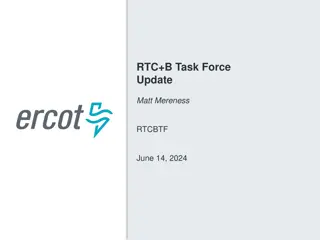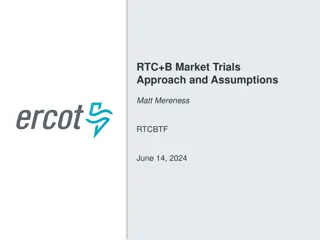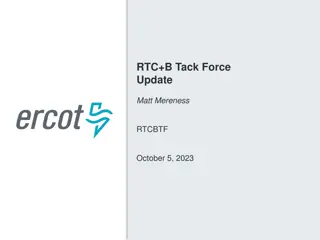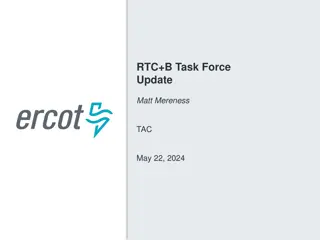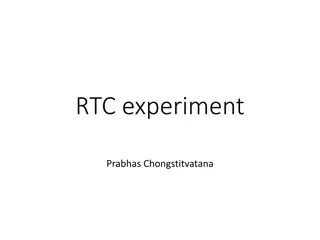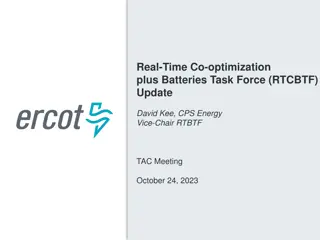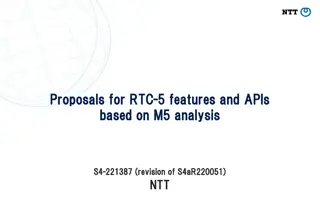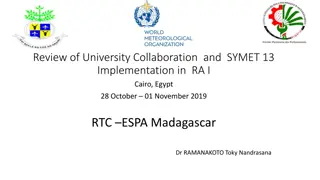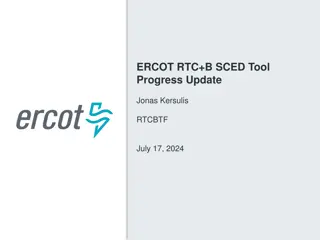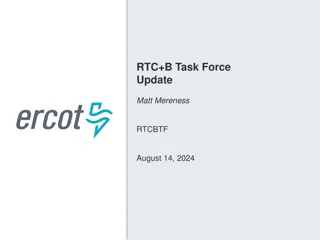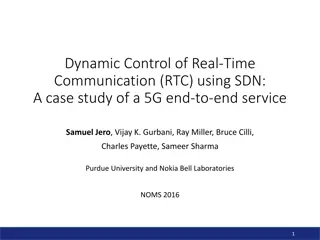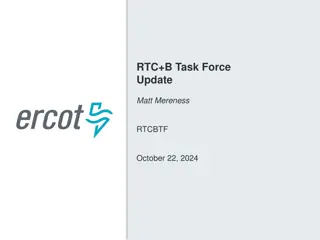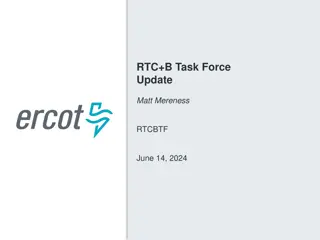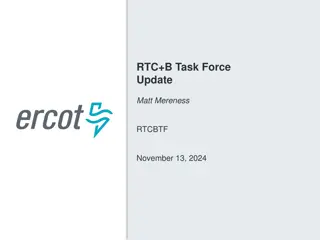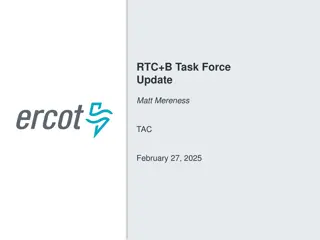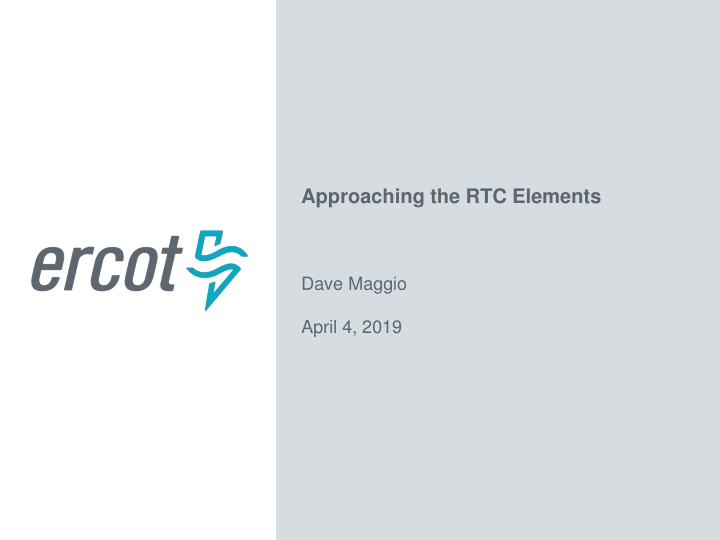
Approach to Real-Time Co-Optimization Elements in Energy Sector
Learn about high-level elements in Real-Time Co-Optimization (RTC) and how to approach each element effectively for optimal deployment, reporting, and performance monitoring in the energy sector. Explore strategies for addressing necessary changes and modifications to enhance efficiency.
Download Presentation

Please find below an Image/Link to download the presentation.
The content on the website is provided AS IS for your information and personal use only. It may not be sold, licensed, or shared on other websites without obtaining consent from the author. If you encounter any issues during the download, it is possible that the publisher has removed the file from their server.
You are allowed to download the files provided on this website for personal or commercial use, subject to the condition that they are used lawfully. All files are the property of their respective owners.
The content on the website is provided AS IS for your information and personal use only. It may not be sold, licensed, or shared on other websites without obtaining consent from the author.
E N D
Presentation Transcript
Approaching the RTC Elements Dave Maggio April 4, 2019
Acronyms Ancillary Services (AS) Current Operating Plan (COP) Day-Ahead Market (DAM) Energy Offer Curve (EOC) ERCOT Contingency Reserve Service (ECRS) High Ancillary Service Limit (HASL) High Sustained Limit (HSL) Load Frequency Control (LFC) Locational Marginal Price (LMP) Low Ancillary Service Limit (LASL) Low Sustained Limit (LSL) Market Clearing Price for Capacity (MCPC) Nodal Protocol Revision Request (NPRR) Non-Spinning Reserve (Non-Spin) Operating Reserve Demand Curve (ORDC) Qualified Scheduling Entity (QSE) Real-Time Co-optimization (RTC) Real-Time Market (RTM) Regulation Down (Reg-Down) Regulation Up (Reg-Up) Reliability Unit Commitment (RUC) Resource Limit Calculator (RLC) Responsive Reserve Service (RRS) Security-Constrained Economic Dispatch (SCED) Supplemental Ancillary Service Market (SASM) System-Wide Offer Cap (SWOC) Under-Frequency Relay (UFR) Value of Lost Load (VOLL) 2 PUBLIC
What are the High-Level Elements of RTC? RTM and AS deployment RUC SASM (removal of the process) DAM Reporting, both internal and external Performance monitoring 3 PUBLIC
How Should Each of These Elements be Approached? Need sufficient understanding to develop Protocol language and requirements For each of the elements, need to address the following questions: 1. Does this element need to change? 2. If so, how do the current processes or functions need to be modified? 3. To accommodate those modifications: i. How do the Market Participant ERCOT data flows need to change (i.e., element inputs)? ii. How do the ERCOT Market Participant data flows need to change (i.e., element outputs)? iii. Does settlement need to change, and if so, how? This will be a useful tool for guiding task force discussions on each of the elements Expect iterations with the task force to go over these questions and develop chapters for the elements 4 PUBLIC
How Should Each of These Elements be Approached? Inputs Inputs Inputs Inputs Inputs Performance RTM and AS Deployment Monitoring Reporting SASM DAM RUC Outputs Outputs Outputs Outputs Outputs Settlement Settlement Settlement 5 PUBLIC
RTM and AS Deployment This element needs to change; high-level discussions have occurred on what some of the process and function changes should be. This area includes the AS manager and LFC There are several details that will drive the answers to the questions below (i.e., participation rules). Market Participant ERCOT and other input changes Telemetry (i.e., ability or inability to provide AS) RLC Currently used to condense information for SCED, such as calculating dispatch limits How that info is condensed will need to change AS demand curves AS offers AS award limitations Amount of UFR RRS unable to arm/disarm Interface for operator to address AS infeasibility concerns (i.e., where deployment of Reg-Up is leading to a constraint violation) 6 PUBLIC
RTM and AS Deployment ERCOT Market Participant changes Telemetry AS awards AS prices Removing the current ORDC price adders Settlement changes Removal of current AS imbalance process Addition of new AS imbalance process that will be AS product specific Rules for managing case where AS on a resource has been deemed infeasible (i.e., where deployment of Reg-Up is leading to constraint violations) Discussion on energy/award weighting for Load Resources pricing 7 PUBLIC
RUC RUC will be modified to co-optimize energy and AS, although base points and AS assignments are not binding Will answer the question: Given the resources planned to be on-line, can power balance and minimum AS requirements be met, and can congestion be resolved? Market Participant ERCOT and other input changes COPs What changes are required to the COP data fields? May need a separate mode for indicating an inability to provide AS AS qualification, including MW qualification for validation AS offers Minimum AS requirements that could potentially be increased, similar to the capability under SASM Discussion on use of ramp rate curves to determine AS capability 8 PUBLIC
RUC ERCOT Market Participant changes Qualified AS capability excess or shortages relative to the minimum AS requirements Settlement changes Updated method to determine capacity shortages for allocation of RUC make-whole costs Updated method for determining claw-back amounts 9 PUBLIC
SASM SASM goes away Includes the removal of all associated procedures, Protocols, reporting and settlement 10 PUBLIC
DAM DAM doesn t inherently need to change under RTC; however, changes are under discussion that may require some of the following: Market Participant ERCOT changes AS offers that aren t tied to a specific resource AS bids AS demand curves Impacts to self-arrangement, especially in the presence of AS bids ERCOT Market Participant changes Cleared AS offers that aren t tied to a specific resource Cleared AS bids Settlement changes? Changes to the existing allocation of AS costs, if AS bids are created 11 PUBLIC
Reporting At a minimum, new reports will be needed for the awarding (MW and price information) Would also retire some of the existing reporting (i.e., reports related to SASM and ORDC price adders) Expect to identify other reports that will be needed as process, input and output changes become more clear 12 PUBLIC
Performance Monitoring At a minimum, some of the methods that are currently used to monitor performance will become obsolete (i.e., the change of RRS schedule telemetry within 1 minute to update HASLs) Like reporting, this is an important element of RTC, but the necessary modifications will likely become more clear as other process, input and output changes become more clear 13 PUBLIC

